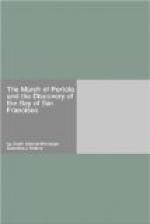Much perplexed by these reports, the governor called a council of officers to deliberate as to the best course to pursue. On Wednesday, October 4th, the council met and after hearing mass, the commander laid the matter before them. He set forth the shortness of their store of provisions, the seventeen men on the sick list, unfit for duty, the excessive burden of labor imposed on the rest in sentinel duty, care of the animals, and continual explorations, and to the lateness of the season. In view of these circumstances, and of the fact that the port of Monterey could not be found where it was said to be, each person present was called upon to express freely his opinion.
Costanso spoke first; Vizcaino had put Monterey in 37deg.; they had only reached 36deg. 42’; they should not fail to explore up to 37deg. 30’, so as either to find the port or decide it did not exist. Fages was for going up to 37deg. or a little more. Rivera thought they should establish themselves somewhere. Then the resolute commander determined to go forward and put his trust in God. If they found the desired port of Monterey and therein the supply-ship San Jose, all would be well. If Monterey did not appear, they would find a place for a settlement; but if it should be the will of God that all were to perish, they would have discharged their duty to God and man in laboring until death in their endeavor to accomplish the enterprise on which they had been sent. To this decision all agreed, and signed their names to the compact.
Ortega and his scouts were now dispatched to lay out the route and locate camping places for several days in advance, and on the 7th of October, the march was resumed. Sixteen sick men had now lost use of their limbs. Each night they were rubbed with oil, and each morning they were put into hammocks swung between two mules, tandem, and thus carried in the mode of travel used by the women of Andalusia[26]. The march was slow and painful. Some of the sick were believed to be in the last extremity, and on October 8th, the holy viaticum was administered to three, who were thought to be dying.
On this day they crossed the Rio del Pajaro, which they named because of a great bird the Indians had killed and stuffed with straw, and which measured seven feet and four inches from the tip of one wing to that of the other. It was thought to be a royal eagle, and that the natives were preparing it for some ceremony when they were frightened away by the approach of the Spaniards. Crespi, who still had a supply of saints on hand, gave the river the name La Senora Santa Ana, but again the saint was ignored, and the river is known as the Pajaro (Bird). On the 17th they crossed and named the Rio de San Lorenzo, at the site of the present city of Santa Cruz. On the 20th they were at Punta de Ano Nuevo, and camped at the entrance of the canon of Waddell creek. They recognized Point Ano Nuevo from the description given by Cabrera Bueno, and Crespi estimated




